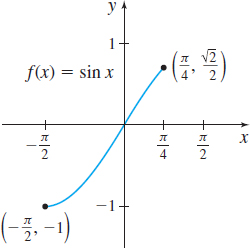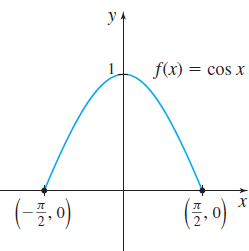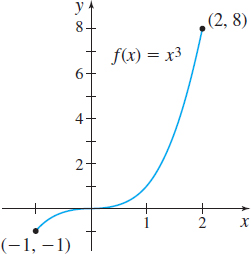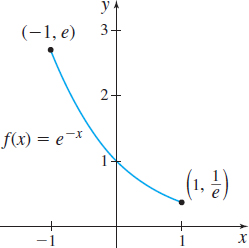5.3 Assess Your Understanding
Concepts and Vocabulary
Question
According to Part 1 of the Fundamental Theorem of Calculus, if a function \(f\) is continuous on a closed interval \([a,b] \), then \(\dfrac{d}{dx}\left[\int_{a}^{x}f(t)\, dt\right] =\) _________ for all numbers \(x\) in \((a,b)\).
Question
True or False By Part 2 of the Fundamental Theorem of Calculus, \(\int_{a}^{b} x\, dx= b-a\).
Question
True or False By Part 2 of the Fundamental Theorem of Calculus, \(\int_{a}^{b}f(x)\, dx=f(b)-f(a).\)
Question
True or False \(\int_{a}^{b} F^\prime (x) dx\) can be interpreted as the rate of change in \(F\) from \(a\) to \(b.\)
Skill Building
In Problems 5–18, find each derivative using Part 1 of the Fundamental Theorem of Calculus.
Question
\(\dfrac{d}{dx}{\int_{1}^{x}{\sqrt{t^{2}+1}\,dt}}\)
Question
\(\dfrac{d}{dx}\int_{3}^{x}\dfrac{t+1}{t}dt \)
Question
\(\dfrac{d}{dt}\left[\int_{0}^{t}{(3+x^{2})^{3/2}dx}\right] \)
Question
\(\dfrac{d}{dx}\left[\int_{-4}^{x}\left({t^{3}+8}\right)^{1/3}dt\right]\)
Question
\(\dfrac{d}{dx}\left[\int_{1}^{x}\ln u \,{du}\right]\)
Question
\(\dfrac{d}{dt}\left[\int_{4}^{t}e^{x}{dx}\right] \)
Question
\(\dfrac{d}{dx}\left[\int_{1}^{2x^{3}} \sqrt{t^{2}+1}\,dt \right] \)
Question
\(\dfrac{d}{dx}\left[\int_{1}^{\sqrt{x}}\sqrt{t^{4}+5} dt \right] \)
Question
\(\dfrac{d}{dx}\left[\int_{2}^{x^{5}}{\sec t} dt \right] \)
Question
\(\dfrac{d}{dx}\left[\int_{3}^{1/x}{\sin }^{5}t dt \right] \)
Question
\(\dfrac{d}{dx}\left[\int_{x}^{5}\sin ({t}^{2} ) \,dt \right] \)
Question
\(\dfrac{d}{dx}\left[\int_{x}^{3}{({t^{2}-5})^{10}\,dt} \right] \)
Question
\(\dfrac{d}{dx}\left[\int_{5x^{2}}^{5}(6t)^{2/3}\,dt \right] \)
Question
\(\dfrac{d}{dx}\left[\int_{x^{2}}^{0}e^{10t}\,dt \right]\)
In Problems 19–36, use Part 2 of the Fundamental Theorem of Calculus to find each definite integral.
Question
\(\int_{-2}^{3}{dx} \)
Question
\(\int_{-2}^{3}{2\,dx} \)
Question
\(\int_{-1}^{2}{x^{3}dx} \)
Question
\(\int_{1}^{3}{\dfrac{1}{x^{3}}dx}\)
Question
\(\int_{0}^{1}\sqrt{u}\,du \)
Question
\(\int_{1}^{8}{\sqrt[3]{{y}}\,dy}\)
![]()
Question
\(\int_{\pi /6}^{\pi /2} \csc ^{2}{x\,dx} \)
Question
\(\int_{0}^{\pi /2}{\cos x\,dx}\)
Question
\(\int_{0}^{\pi /4}\sec x\tan x~dx\)
Question
\(\int_{\pi /6}^{\pi /2}\csc x\cot x\,dx\)
Question
\(\int_{-1}^{0}e^{x}dx \)
Question
\(\int_{-1}^{0}e^{-x}dx \)
Question
\(\int_{1}^{e}\dfrac{1}{x}dx\)
Question
\(\int_{e}^{1}\dfrac{1}{x}dx \)
Question
\(\int_{0}^{1}\dfrac{1}{1+x^{2}}dx \)
Question
\(\int_{0}^{\sqrt{2}/2}\dfrac{1}{\sqrt{1-x^{2}}}dx\)
Question
\(\int_{-1}^{8}x^{2/3}\,dx\)
Question
\(\int_{0}^{4}x^{3/2}\,dx\)
367
In Problems 37–42, find \(\int_{a}^{b}f(x) \,dx\) over the domain of \(f\) indicated in the graph.
Question

Question

Question

Question

Question

Question

Question
Given that \(f(x)=(2x^{3}-3)^{2}\) and \(f^\prime (x) =12x^{2}(2x^{3}-3),\) find \(\int_{0}^{2}[12x^{2}(2x^{3}-3)]\, dx.\)
Question
Given that \(f(x)=(x^{2}+5)^{3}\) and \(f^\prime (x) =6x(x^{2}+5) ^{2},\) find \(\int_{-1}^{2}{6x(x^{2}+5)^{2}\, dx.}\)
Applications and Extensions
Question
Area Find the area under the graph of \(f(x) =\dfrac{1}{\sqrt{1-x^{2}}}\) from \(0\) to \(\dfrac{1}{2}.\)
Question
Area Find the area under the graph of \(f(x) =\cosh x\) from \(-1\) to \(1\).
Question
Area Find the area under the graph of \(f(x) =\dfrac{1}{x^{2}+1}\) from \(0\) to \(\sqrt{3}.\)
Question
Area Find the area under the graph of \(f(x) =\dfrac{1}{1+x^{2}}\) from \(0\) to \(r\), where \(r>0\). What happens as \(r\rightarrow \infty \)?
Question
Area Find the area under the graph of \(y=\dfrac{1}{\sqrt{x}} \) from \(x=1\) to \(x=r\), where \(r>1\). Then examine the behavior of this area as \(r\rightarrow \infty \).
Question
Area Find the area under the graph of \(y=\dfrac{1}{x^{2}}\) from \(x=1\) to \(x=r\), where \(r>1\). Then examine the behavior of this area as \(r\rightarrow \infty \).
Question
Interpreting an Integral The function \(R=R(t) \) models the rate of sales of a corporation measured in millions of dollars per year as a function of the time \(t\) in years. Interpret the integral \(\int_{0}^{2}R(t)\,dt=23\).
Question
Interpreting an Integral The function \(v=v( t) \) models the speed \(v\) in meters per second of an object at a time \(t\) in seconds. Interpret the integral \(\int_{0}^{10}v(t)\,dt=4.8.\)
Question
Interpreting an Integral Helium is leaking from a large advertising balloon at a rate of \(H(t) \) cubic centimeters per minute, where \(t\) is measured in minutes.
- Write an integral that models the change in helium in the balloon over the interval \(a\leq t\,\leq b.\)
- What are the units of the integral from (a)?
- Interpret \(\int_{0}^{300}H(t)\, dt=-100.\)
Question
Interpreting an Integral Water is being added to a reservoirat a rate of \(w(t) \) kiloliters per hour, where \(t\) is measured in hours.
- Write an integral that models the change in amount of water in the reservoir over the interval \(a\leq t\,\leq b.\)
- What are the units of the integral from (a)?
- Interpret \(\int_{0}^{36}w(t)\, dt=800.\)
Question
Free Fall The speed \(v\) of an object dropped from rest is given by \(v(t) =9.8t\), where \(v\) is in meters per second and time \(t\) is in seconds.
- Express the distance traveled in the first \(5.2\) s as an integral.
- Find the distance traveled in \(5.2\) s.
Question
Area Find \(h\) so that the area under the graph of \(y^{2}=x^{3}, 0\leq x\leq 4, y\geq 0\), is equal to the area of a rectangle of base \(4\) and height \(h\).
Question
Area If \(P\) is a polynomial that is positive for \(x>0\), and for each \(k>0\) the area under the graph of \(P\) from \(x=0\) to \(x=k\) is \(k^{3}+3k^{2}+6k\), find \(P\).
Question
Put It Together If \(f(x)={\int_{0}^{x}}\dfrac{{1}}{\sqrt{t^{3}+2}}\,dt\), which of the following is false?
- \(f\) is continuous at \(x\) for all \(x\geq 0\)
- \(f(1)>0\)
- \(f(0) =\dfrac{1}{\sqrt{2}}\)
- \(f^\prime (1)=\dfrac{1}{\sqrt{3}}\)
368
In Problems 59–62:
- Use Part of 2 the Fundamental Theorem of Calculus to find each definite integral.
- Determine whether the integrand is an even function, an odd function, or neither.
- Can you make a conjecture about the definite integrals in (a) based on the analysis from (b)? Look at Objective 3 in Section 5.6.
Question
\(\int_{0}^{4}x^{2}dx\) and \(\int_{-4}^{4}x^{2}dx\)
Question
\(\int_{0}^{4}x^{3}dx\) and \(\int_{-4}^{4}x^{3}dx\)
Question
\(\int_{0}^{\pi /4}\sec ^{2}x\,dx\) and \(\int_{-\pi /4}^{\pi /4}\sec ^{2}x\,dx\)
Question
\(\int_{0}^{\pi /4}\sin x\,dx\) and \(\int_{-\pi /4}^{\pi /4}\sin x\,dx\)
Question
Area Find \(c\), \(0\lt c\lt 1\), so that the area under the graph of \(y=x^2\) from 0 to \(c\) equals the area under the same graph from \(c\) to 1.
Question
Area Let \(A\) be the area under the graph of \(y=\dfrac{1}{x}\) from \(x=m\) to \(x=2m\), \(m>0\). Which of the following is true about the area \(A\)?
- \(A\) is independent of \(m.\)
- \(A\) increases as \(m\) increases.
- \(A\) decreases as \(m\) increases.
- \(A\) decreases as \(m\) increases when \(m\lt\dfrac{1}{2}\) and increases as \(m\) increases when \(m>\dfrac{1}{2}.\)
- \(A\) increases as \(m\) increases when \(m\lt\dfrac{1}{2}\) and decreases as \(m\) increases when \(m>\dfrac{1}{2}.\)
Question
Put It Together If \(F\) is a function whose derivative is continuous for all real \(x\), find \[ \lim\limits_{{_{h\rightarrow 0}}}{\dfrac{{1}}{{h}}}{\int_{c}^{c+h}{{F^\prime } (x)\,dx}} \]
Question
Suppose the closed interval \(\left[ 0,\dfrac{\pi }{2}\right] \) is partitioned into \(n\) subintervals, each of length \(\Delta x\), and \(u_{i}\) is an arbitrary number in the subinterval \([x_{i - 1},\,x_{i}],\) \(i\,=1,\,2,\,\ldots ,\,n\). Explain why \[ \lim\limits_{{n\,\rightarrow \,\infty }}\,{\sum\limits_{i=1}^{n}}\left[ {{({ \cos }\,u_{i})\,\Delta x}}\right] ={1} \]
Question
The interval \([0,4]\) is partitioned into \(n\) subintervals, each of length \(\Delta x\), and a number \(u_{i}\) is chosen in the subinterval \([x_{i-1},\,x_{i}],\) \(i=1,\,2,\,\ldots ,\,n\). Find \(\lim\limits_{n\rightarrow \infty }{\sum\limits_{i=1}^{n}}( e^{u_1} \Delta x) .\)
Question
If \(u\) and \(\nu \) are differentiable functions and \(f\) is a continuous function, find a formula for \[ {\dfrac{{d}}{{dx}}}{\left[ {{\int_{u(x)}^{\nu (x)}{f(t)\,dt}}}\right] } \]
Question
Suppose that the graph of \(y=f(x)\) contains the points \((0,1)\) and \((2,5) \). Find \(\int_{0}^{2}f^\prime (x)\,dx\). (Assume that \(f^\prime \) is continuous.)
Question
If \(f^\prime \) is continuous on the interval \([a,b] \), show that \[ \int_{a}^{b} f(x) f^\prime (x)\,dx=\dfrac{1}{2} \Big\{ [f(b)]^{2}-[f(a)]^{2} \Big\}. \]
[Hint: Look at the derivative of \(F(x) =\dfrac{\left[f(x) \right] ^{2}}{2}.]\)
Question
If \(f^{\prime \prime} \) is continuous on the interval \([a,b] \), show that \[ \int_{a}^{b} xf^{\prime \prime} (x)\,dx=bf^\prime (b)-a f^\prime (a)-f(b)+f(a). \]
[Hint: Look at the derivative of \(F(x)=xf^\prime (x)-f(x).\)]
Challenge Problems
Question
What conditions on \(f\) and \(f^\prime\) guarantee that \(f(x)={\int_{0}^{x}{{f^\prime }(t)\,dt}}\)?
Question
Suppose that \(F\) is an antiderivative of \(f\) on the interval \([a,b] .\) Partition \([a,b] \) into \(n\) subintervals, each of length \(\Delta x_{i}=x_{i}-x_{i-1},\) \(i=1,2,\ldots,n\).
- Apply the Mean Value Theorem for derivatives to \(F\) in each subinterval \([x_{i-1},x_{i}]\) to show that there is a point \(u_{i}\) in the subinterval for which \(F(x_{i})-F(x_{i-1})=f(u_{i})\Delta x_{i}\).
- Show that \(\sum\limits_{i=1}^{n}[F(x_{i})-F(x_{i-1})]=F(b)-F(a).\)
- Use parts (a) and (b) to explain why \[ \int_{a}^{b}f(x)\,dx = F(b)-F(a). \] (In this alternate proof of Part 2 of the Fundamental Theorem of Calculus, the continuity of \(f\) is not assumed.)
Question
Given \(y=\sqrt{x^{2} - 1} (4 - x),\) \(1\leq x\leq a\), for what number \(a\) will \(\int_{1}^{a}y\,dx\) have a maximum value?
Question
Find \(a>0\), so that the area under the graph of \(y=x+\dfrac{1}{x}\) from \(a\) to \((a+1) \) is minimum.
Question
If \(n\) is a known positive integer, for what number \(c\) is \[ \int_{1}^{c}x^{n-1}\,dx=\dfrac{1}{n} \]
Question
Let \(f(x)={\int_{0}^{x}{{\dfrac{dt}{\sqrt{1-t^{2}}}}, 0 \lt x \lt 1.}}\)
- Find \(\dfrac{d}{dx} f(\sin x).\)
- Is \(f\) one-to-one?
- Does \(f\) have an inverse?
